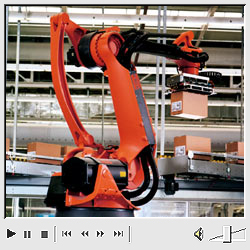|
Starting
point / Task definition
At CD Cartondruck AG, a leading manufacturer of exclusive
packaging for cosmetics, the stacking of cartons on
pallets used to be carried out by two employees in every
shift. This strenuous work meant that up to 3,000 cartons
with an average weight of 7 kg had to be handled in
each shift. In order
to ease the load on the employees, the company was looking
for an automated solution. The primary requirements
specified by the user were short cycle times, flexibility
and simple operator control.
Implementation / Solution
 The strenuous physical work is now
carried out by two KUKA KR 180 PA palletizing robots.
Each robot loads pallets located on three roller conveyors.
The KR 180 PAs insert cardboard slipsheets to help ensure
maximum stability at all times. They load the pallets
up to a height of 2.2 meters, which corresponds to five
or six layers. As soon as one of the pallets is full,
the robot controller generates a “finished”
signal. The pallet then rolls forward to a transfer
position, where it is picked up by a transverse shuttle
and taken to a neighboring high-bay warehouse. The strenuous physical work is now
carried out by two KUKA KR 180 PA palletizing robots.
Each robot loads pallets located on three roller conveyors.
The KR 180 PAs insert cardboard slipsheets to help ensure
maximum stability at all times. They load the pallets
up to a height of 2.2 meters, which corresponds to five
or six layers. As soon as one of the pallets is full,
the robot controller generates a “finished”
signal. The pallet then rolls forward to a transfer
position, where it is picked up by a transverse shuttle
and taken to a neighboring high-bay warehouse.
In order to facilitate operator control
for 70 different sizes of cartons, which have to be
palletized using some 15 different stacking patterns,
the KUKA Control Panel has been provided with an extended
user interface. This was done by superimposing a customer-specific
user interface on top of the robot programming interface;
this simplifies operator control of the system and provides
assistance to employees in the event of a fault. The
user can create the necessary stacking patterns with
an absolute minimum of programming effort, and can then
call them up later as required for the specific task.
The reduction in programming work is largely due to
the PalletTech application software, which makes it
easier to calculate the ideal pallet structure, for
example.
System components / Scope of supply
Two KUKA KR 180 PA palletizing robots
Two PC-based KR C2 robot controllers, including control
panel with Windows interface
Two suction grippers
Infeed conveyor system from the automatic carton closing
unit
Labeling
Outgoing conveyor system, including turntable and buffer
segment in high-bay warehouse
Three empty pallet dispensers
Safeguards
System control using two Soft PLCs
Programming via the KUKA Control Panel without additional
hardware
Data transfer via ASI bus for decentralized control
architecture
Supplied by KUKA systems partner FPT
Robotik GmbH & Co., Amtzell, Germany.
Results / Success
Flexibility
Because the size of the cartons to be
handled changes at least twice per shift, Cartondruck
decided in favor of the KR 180 PAs, and not the possible
alternative, gantry robots, which would have been less
flexible and also slower with regard to retooling. The
flexibility of these palletizing robots is based on
their suction cup gripper, which is designed for a payload
of 25 kg and carton sizes with a surface area from 150
x 380 mm to 380 x 500 mm. Moreover, compared with mechanical
grippers, the suction gripper reduces the risk of damage
to the high-quality folding boxes.
Speed
Given that up to 600 cartons had to
be palletized per hour, Cartondruck required a cycle
time of twelve seconds per robot. Since each of the
KR 180 PAs achieves up to 1800 palletizing cycles per
hour, they have no trouble meeting this requirement.
Cost-effectiveness
The KR 180 PA “palletizing expert”
is a four-axis robot with a passive fifth axis, whose
application-specific, FEM-optimized kinematic system
guarantees particularly efficient, and thus cost-effective,
palletizing processes. Its arm is made of carbon fiber
composite material (CRP), which thanks to its smaller
mass moment of inertia, provides truly remarkable acceleration
rates. Despite its lightweight construction, the arm
demonstrates extremely high stiffness characteristics,
allowing the KR 180 PA to stack loads weighing up to
180 kg to heights of up to 3000 mm. In any case, this
automated solution is more economical, since compared
to manual handling the robots operate with a minimized
error rate in order-specific palletizing.
|
